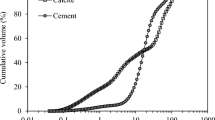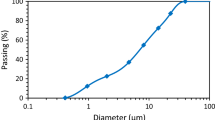Abstract
The superplasticized cement paste usually exhibits non-Newtonian characteristics, which depend on the type of superplasticizer and its dosage. Current attempts in the cement paste rheology literature have mainly focused on reducing the data from steady shear experiments to simple constitutive models, and exploring the influence of superplasticizer dosage and type based on these model parameters. In this study, the non-Newtonian behavior of the cement paste is characterized based on more fundamental experimental investigations without recourse to any specific model. Steady shear, creep and recovery, and stress relaxation experiments were conducted on a variety of superplasticizer and cement paste combinations, and the transition from non-linear viscoelastic to non-Newtonian and subsequently to linearly viscous fluid, as the dosage is increased were observed. Additionally, Marsh cone experiments were conducted to determine the optimum dosages and it was found that dosages determined based on Marsh cone were close to the dosages at the transition to the linearly viscous behaviour.












Similar content being viewed by others
References
Papo A, Piani L (2004) Effect of various superplasticizers on the rheological properties of portland cement pastes. Cem Concr Res 34:2097–2101
Jayasree C, Gettu R (2008) Experimental study of the flow behaviour of superplasticized cement paste. Mater Struct 41:1581–1593
Struble L, Sun GK (1995) Viscosity of portland cement paste as a function of concentration. Adv Cem Mater 2:62–69
Cyr M, Legrand C, Mouret M (2000) Study of the shear thickening effect of superplasticizers on the rheological behaviour of cement pastes containing or not mineral additives. Cem Concr Res 30:1477–1483
Roy DM, Asaga K (1980) Rheological properties of cement mixes: V. The effects of time on viscometric properties of mixes containing superplasticizers; conclusions. Cem Concr Res 10:389–394
Masood I, Agarwal SK (1994) Effect of various superplasticizers on rheological properties of cement paste and mortars. Cem Concr Res 24(2):291–302
Ferraris CF, Obla KH, Hill R (2001) The influence of mineral admixtures on the rheology of cement paste and concrete. Cem Concr Res 31:245–255
Park CK, Noh MH, Park TH (2005) Rheological properties of cementitious materials containing mineral admixtures. Cem Concr Res 35:842–849
Schwartzentruber LD, Roy R, Cordin J (2006) Rheological behaviour of fresh cement pasts formulated from a self compacting concrete (SCC). Cem Concr Res 36:1203–1213
Asaga K, Roy DM (1980) Rheological properties of cement mixes: IV—effects of superplasticizers on viscosity and yield stress. Cem Concr Res 10:287–295
Banfill PFG (1981) A viscometric study of cement pastes containing superplasticizers with a note on experimental techniques. Mag Concr Res 33(114):37–47
Nehdi M, Rahman MA (2004) Estimating rheological properties of cement pastes using various rheological models for different test geometry, gap and surface friction. Cem Concr Res 34:1993–2007
Mansoutre S, Colombet P, Van Damme H (1999) Water retention and granular rheological behaviour of fresh C3S paste as a function of concentration. Cem Concr Res 29:1441–1453
Struble LJ, Schultz MA (1993) Using creep and recovery to study flow behaviour of fresh cement paste. Cem Concr Res 23:1369–1379
Sun Z, Voigt T, Shah SP (2006) Rheometric and ultrasonic investigations of viscoelastic properties of fresh portland cement pastes. Cem Concr Res 36:278–287
Min BH, Erwin L, Jennings HM (1994) Rheological behaviour of fresh cement paste as measured by squeeze flow. J Mater Sci 29:1374–1381
Chen CT, Struble LJ, Zhang H (2006) Using dynamic rheology to measure cement–admixture interactions. J ASTM Int 3(3):1–13
IS 12269 (2004) Indian standard specification for 53 grade ordinary portland cement. Bureau of Indian Standards, New Delhi
Jayasree C (2009) Study of cement–superplasticizer interaction and its implications for concrete performance. Doctoral thesis, Indian Institute of Technology Madras, India
Lootens D, Hebraud P, Lecolier E, Damme HV (2004) Gelation, shear-thinning and shear thickening in cement slurries. Oil Gas Sci Technol Rev IFP 59(1):31–40
Chougnet A, Audibert A, Moan M (2007) Linear and non-linear rheological behaviour of cement and silica suspensions. Effect of polymer addition. Rheol Acta 46:793–802
Tschoegl NW (1989) The phenomenological theory of linear viscoelastic behaviour—an introduction. Springer, Berlin
ASTM D 2196-05. Standard test methods for rheological properties of non-Newtonian materials by rotational (Brookfield type) viscometer. ASTM International, USA
Lapasin R, Papo A, Rajgelj S (1983) The phenomenological description of the thixotropic behaviour of fresh cement pastes. Rheol Acta 22:410–416
Atzeni C, Massida L, Sanna U (1985) Comparison between rheological models for portland cement pastes. Cem Concr Res 15:511–519
Geiker MR, Mari B, Nyholm Lars, Lauge N (2002) On the effect of coarse aggregate fraction and shape on the rheological properties of self compacting concrete. Cem Concr Aggreg 24(1):3–6
Struble LJ, Lei W-G (1995) Rheological changes associated with setting of cement paste. Adv Cem Mater 2:224–230
Wineman AS, Rajagopal KR (2000) Mechanical response of polymers. Cambridge University Press, Cambridge
Acknowledgments
Partial funding for this work was provided through grant number SR/S3/MERC/29/2006 by the Department of Science Technology, Government of India and grant number CIE/04-05/122/NFSC/RAVG by IIT Madras. The discussions with Dr. Abhijit P Deshpande, Department of Chemical Engineering, IIT Madras on the use of dynamic shear rheometer are gratefully acknowledged.
Author information
Authors and Affiliations
Corresponding author
Rights and permissions
About this article
Cite this article
Jayasree, C., Murali Krishnan, J. & Gettu, R. Influence of superplasticizer on the non-Newtonian characteristics of cement paste. Mater Struct 44, 929–942 (2011). https://doi.org/10.1617/s11527-010-9677-6
Received:
Accepted:
Published:
Issue Date:
DOI: https://doi.org/10.1617/s11527-010-9677-6




